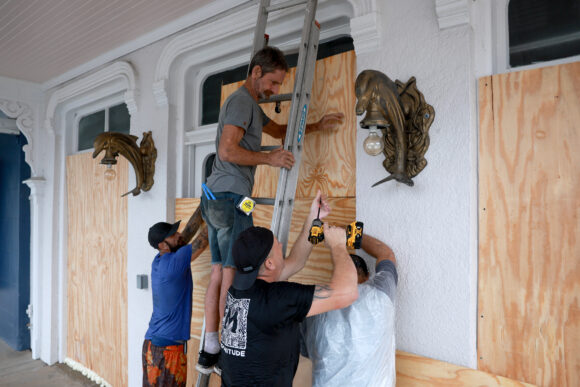Hurricane Debby slammed into Florida southeast of Tallahassee as a Category 1 storm after intensifying over warm waters, the latest evidence that this will be a robust season for tropical cyclones.
The storm’s top winds reached 80 miles (130 kilometers) per hour when it came ashore Monday morning near Steinhatchee in the state’s sparsely populated Big Bend region, not far from where Hurricane Idalia hit in August 2023.
Months of record warm water across the Atlantic has raised alarm that 2024 would be a very hurricane active season. Put simply: ocean heat is the fuel that powers tropical cyclones.
Debby is already the second storm to make landfall in the US this year following Beryl, which struck eastern Texas last month and caused a massive power outage. The Atlantic basin typically doesn’t produce its second system with winds of at least 74 mph until August 26.
Debby is now forecast to slowly wring out flooding rain across northern Florida and Georgia. More than 200,000 homes and businesses were without power in Florida at 7:15 a.m. local time, according to Poweroutage.us, which tracks utility outages.
“This is a life-threatening situation,” Richard Pasch, a senior hurricane specialist at the center, wrote in a forecast. “Potentially historic heavy rainfall across southeast Georgia and South Carolina through Friday morning will likely result in areas of catastrophic flooding.”
President Joe Biden declared an emergency in Florida and ordered federal resources to help the state, the White House said. Florida Governor Ron DeSantis and Georgia Governor Brian Kemp have declared emergencies in their states. Florida’s Dixie County ordered coastal residents to flee, and adjacent Taylor County has opened shelters.
Florida coastal areas may see upward of $250 million in damage and losses. If the storm causes widespread flooding across the South, particularly around Savannah, Georgia, and Charleston, South Carolina, the tally may rise as high as $1 billion, said Chuck Watson, a disaster modeler at Enki Research.
Read More: How ‘Rapid Intensification’ Transforms Hurricanes: QuickTake
Western Florida in recent years has been battered by storms including Category 5 Michael in 2018 — which killed at least 16 people in the US — and Ian, which struck as a Category 4 storm in 2022, leaving more than 160 dead. A year ago, Hurricane Idalia made landfall in the Big Bend area as a Category 3 hurricane.
In addition to Debby, forecasters are watching a second potential Atlantic storm that may push into the western Caribbean later this week and has a 10% chance of becoming the season’s next storm.
Photo: Protective measures at a business ahead of Hurricane Debby in Cedar Key, Florida, US, on Aug. 4. Joe Raedle/Getty Images
Was this article valuable?
Here are more articles you may enjoy.



 How a Perfect Storm Sent Church Insurance Rates Skyrocketing
How a Perfect Storm Sent Church Insurance Rates Skyrocketing  Local Opposition Challenges Wind Farm Development in Rural Nebraska
Local Opposition Challenges Wind Farm Development in Rural Nebraska  AIG’s Repositioning Affects Q2 Earnings; Underlying Underwriting Income Up 2%
AIG’s Repositioning Affects Q2 Earnings; Underlying Underwriting Income Up 2%  Private Equity Firm Centerbridge Weighs Exit Options for £3 Billion Canopius at Lloyd’s
Private Equity Firm Centerbridge Weighs Exit Options for £3 Billion Canopius at Lloyd’s 

